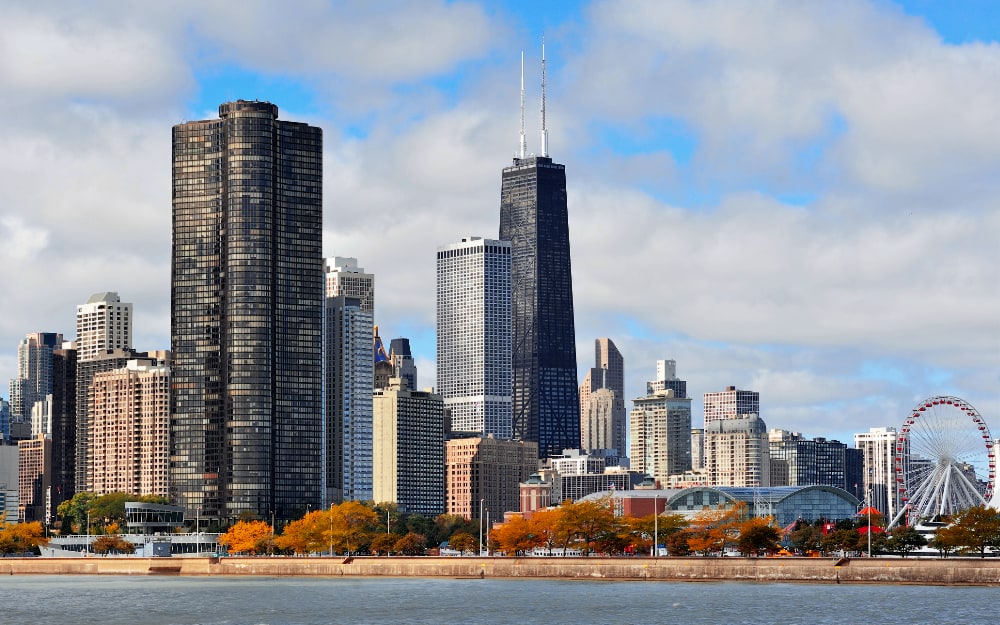Population in Urban Area, now
- World: 43rd
- North America: 4th
- United States: 3rd
Chicago Urban Area Population Graph
Chicago Population Review
On the shores of Lake Michigan sits Chicago, the third-largest city in the United States. Famous for its architecture and museums, Chicago is an economic powerhouse with an ever-growing population. Nicknamed the “Windy City”, Chicago has been home to droves of celebrities, authors, Nobel laureates and Fields medalists—as well as some very infamous crime bosses. The population in the city area in mid-2020 surpassed 2.7 million, making Chicago one of the United States’ most populous cities.
Chicago is part of the wider Chicago-Joliet-Naperville Metropolitan Area, a 20,000 sq. kilometer expanse with almost 9 million residents. Also called Chicagoland, this urban area is predicted to continue steadily growing with statistics forecasting over 9.8 million residents by 2035. Chicago has shown steady growth since 1950 when the urban area had just under 5 million people calling the area home.
A boomtown from the beginning
Founded in 1833, Chicago’s population boomed almost immediately. By the time of its first census, Chicago had 4,000 residents. This was nothing to scoff at in 1833. In comparison, New York City, which was founded in 1624, only had about 200,000 people living in it by the 1830s. Chicago continued to grow at an exponential rate and by 1890, the census calculated over a million people living in Chicago. Wave after wave of immigration continued to balloon the population until it evened out in the 1950s.
Demographics in the city
Chicago has a checkered past when it comes to racial diversity. Most of the city’s white population lives in the Northern part of the city, while its black population lives in the South. This distribution has much to do with Chicago’s previously racist housing allocation policy that forced the city’s black population to reside in the cheaper, less sought-after section of the city: Chicago’s South Side. Historical data has also shown that many of the people leaving the city’s core for the suburban neighborhoods are from Chicago’s affluent white population. The population of non-Hispanic whites within the city has fallen from 59% in 1970, to 31% in 2010, and continuing to fall.
A city of music
Many of Chicago’s residents (past and present) were renowned musicians. The city is considered the birthplace of genres of music like gospel, electric blues, juke, footwork, and house music. To this day, Chicago is a city that builds much of its identity around music with 250 live music venues and 74 music festivals, all generously attended by residents and visitors alike. Some of Chicago’s most famed musicians include Louis Armstrong, Kanye West, Muddy Waters, Smashing Pumpkins, Jennifer Hudson, and Earth, Wind & Fire.
The Famous Fire
The Great Chicago Fire was a massive fire that ripped through the city for two days in 1871. Started on October 8, the fire started in a neighborhood southwest of the city center. This famous fire decimated 3.3 square miles of the city and killed 300 people, caused $200 million in damages, and left 100,000 people homeless. While the fire was devastating, it spurned many positive changes Chicagoans still benefit from today, including the establishment of the Chicago Public Library—the city’s first free library.
Crime in Chicago
Chicago’s violent crime rate is higher than the US average. In 2016 alone, Chicago was responsible for almost half of all the homicides committed in the US in one year. The city’s violent and major crime rate began to rise in the 1960s, declined in overall crime in the 2000s, and then increased in homicides in 2016. The murder rate in Chicago is 15.65 per 100,000, which makes it one of the most dangerous cities in the United States. However, the city’s homicide rate has steadily decreased since 2016. In 2019, the city recorded 490 murders, which is 13% lower than the 564 murders of 2018. This is also 35% less than the city’s deadliest year of 2016. Shootings are also down, with the city recording about 9.6% less shootings.
